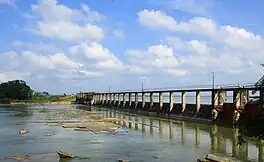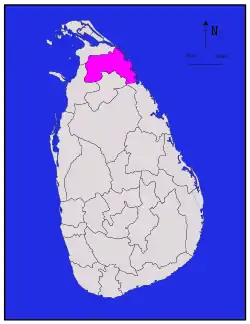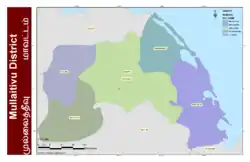Mullaitivu District
முல்லைத்தீவு மாவட்டம் මුලතිවු දිස්ත්රික්කය | |
|---|---|
 | |
 Location within Sri Lanka | |
 DS and GN Divisions of Mullaitivu District, 2006 | |
| Coordinates: 09°14′N 80°32′E / 9.233°N 80.533°E | |
| Country | Sri Lanka |
| Province | Northern |
| Created | September 1978 |
| Capital | Mullaitivu |
| DS Division | |
| Government | |
| • District Secretary | N. Vethanayagam |
| • MPs | List
|
| • MPCs | List
|
| Area | |
| • Total | 2,617 km2 (1,010 sq mi) |
| • Land | 2,415 km2 (932 sq mi) |
| • Water | 202 km2 (78 sq mi) 7.72% |
| • Rank | 11th (3.99% of total area) |
| Population (2012 census)[2] | |
| • Total | 91,947 |
| • Rank | 25th (0.45% of total pop.) |
| • Density | 35/km2 (91/sq mi) |
| Ethnicity (2012 census)[2] | |
| • Sri Lankan Tamil | 79,081 (86.01%) |
| • Sinhalese | 8,851 (9.63%) |
| • Indian Tamil | 2,182 (2.37%) |
| • Sri Lankan Moors | 1,760 (1.91%) |
| • Other | 73 (0.08%) |
| Religion (2012 census)[3] | |
| • Hindu | 69,628 (75.73%) |
| • Christian | 11,989 (13.04%) |
| • Buddhist | 8,155 (8.87%) |
| • Muslim | 2,013 (2.19%) |
| • Other | 162 (0.18%) |
| Time zone | UTC+05:30 (Sri Lanka) |
| Post Codes | 42000-42999 |
| ISO 3166 code | LK-45 |
| Vehicle registration | NP |
| Official Languages | Tamil, Sinhala |
| Website | Mullaitivu District Secretariat |
Mullaitivu District (Tamil: முல்லைத்தீவு மாவட்டம் Mullaittīvu Māvaṭṭam; Sinhala: මුලතිවු දිස්ත්රික්කය) is one of the 25 districts of Sri Lanka, the second level administrative division of the country. The district is administered by a District Secretariat headed by a District Secretary (previously known as a Government Agent) appointed by the central government of Sri Lanka. The capital of the district is the town of Mullaitivu.
History
Parts of present-day Mullaitivu District was part of the pre-colonial Jaffna kingdom.[4] The district then came under Portuguese, Dutch and British control. In 1815 the British gained control of the entire island of Ceylon. They divided the island into three ethnic based administrative structures: Low Country Sinhalese, Kandyan Sinhalese and Tamil. The district, which was then part of Vanni District, was part of the Tamil administration. In 1833, in accordance with the recommendations of the Colebrooke-Cameron Commission, the ethnic based administrative structures were unified into a single administration divided into five geographic provinces.[5] Vanni District, together with Jaffna District and Mannar District, formed the new Northern Province.[6]
Vanni District was later renamed Mullaitivu District and then Vavuniya District. The district was colonised in the second half of the 18th century by residents from Jaffna Peninsula, primarily from Alaveddy, Udupiddy and Navaly.[7] At the time that Ceylon gained independence, Vavuniya was one of the three districts located in the Northern Province. Mullaitivu District was carved out of the northern part of Vavuniya District together with parts of the then Jaffna District, Mannar District and Trincomalee District in September 1978.
Mullaitivu District was under the control of rebel Liberation Tigers of Tamil Eelam for many years during the civil war. The district was recaptured by the Sri Lankan military in early 2009.
Geography
Mullaitivu District is located in the north east of Sri Lanka in the Northern Province. It has an area of 2,617 square kilometres (1,010 sq mi).[1]
Administrative units
Mullaitivu District is divided into 6 Divisional Secretary's Division (DS Divisions), each headed by a Divisional Secretary (previously known as an Assistant Government Agent).[8] The DS Divisions are further sub-divided into 136 Grama Niladhari Divisions (GN Divisions).[8]
| DS Division | Main Town | Divisional Secretary | GN Divisions [8] |
Area (km2) [8][9] |
Population (2012 Census)[10] | Population Density (/km2) | |||||
|---|---|---|---|---|---|---|---|---|---|---|---|
| Sri Lankan Tamil | Sinhalese | Indian Tamil | Sri Lankan Moors | Other | Total | ||||||
| Manthai East | Pandiyankulam | N.Ranjana | 15 | 515 | 6,277 | 10 | 634 | 8 | 0 | 6,929 | |
| Maritimepattu | Mullaitivu | M.Umamagal | 46 | 744 | 25,976 | 1,071 | 150 | 1,678 | 34 | 28,909 | |
| Oddusuddan | Oddusuddan | P.Jeyarani | 27 | 639 | 14,158 | 792 | 51 | 31 | 15,658 | ||
| Puthukkudiyiruppu | Puthukkudiyiruppu | S.jeyakanth | 19 | 371 | 23,480 | 50 | 215 | 19 | 6 | 23,770 | |
| Thunukkai | Thunukkai | A.Lathumeera | 20 | 344 | 9,180 | 157 | 391 | 2 | 2 | 9,732 | |
| Weli Oya (Manal Aru) | Ehatugaswewa | 9 | 180 | 10 | 6,937 | 0 | 2 | 0 | 6,949 | ||
| Total | 136 | 2,617 | 79,081 | 8,851 | 2,182 | 1,760 | 73 | 91,947 | 35 | ||
Demographics
Population
Mullaitivu District's population was 91,947 in 2012.[2] The population of the district is mostly Sri Lankan Tamil.
The population of the district, like the rest of the north and east of Sri Lanka, has been heavily affected by the civil war. The war killed an estimated 100,000 people.[11] Several hundred thousand Sri Lankan Tamils, possibly as much as one million, emigrated to India or to the West during the war.[12] Many Sri Lankan Tamils also moved to the relative safety of the capital Colombo. Most of the Sri Lankan Moors and Sinhalese who lived in the district fled to other parts of Sri Lanka or were forcibly expelled by the rebel Liberation Tigers of Tamil Eelam, though most of them have returned to the district since the end of the civil war.
Ethnicity
| Year | Tamil[lower-alpha 1] | Sinhalese | Muslim[lower-alpha 2] | Other | Total No. | ||||
|---|---|---|---|---|---|---|---|---|---|
| No. | % | No. | % | No. | % | No. | % | ||
| 1981 Census | 69,670 | 89.88% | 3,948 | 5.09% | 3,777 | 4.87% | 117 | 0.15% | 77,512 |
| 1999 Estimate | n/a | n/a | n/a | n/a | n/a | n/a | n/a | n/a | 184,655 |
| 2000 Estimate | n/a | n/a | n/a | n/a | n/a | n/a | n/a | n/a | 187,281 |
| 2001 Estimate[lower-alpha 3] | n/a | n/a | n/a | n/a | n/a | n/a | n/a | n/a | 180,401 |
| 2002 Estimate | n/a | n/a | n/a | n/a | n/a | n/a | n/a | n/a | 144,959 |
| 2003 Estimate | 140,556 | 99.92% | 23 | 0.02% | 49 | 0.03% | 47 | 0.03% | 140,675 |
| 2004 Estimate | 152,724 | 99.83% | 0 | 0.00% | 237 | 0.15% | 29 | 0.02% | 152,990 |
| 2005 Estimate | 157,410 | 99.77% | 0 | 0.00% | 365 | 0.23% | 0 | 0.00% | 157,775 |
| 2006 Estimate | 214,713 | 99.75% | 1 | 0.00% | 547 | 0.25% | 0 | 0.00% | 215,261 |
| 2007 Estimate | 220,117 | 99.91% | 1 | 0.00% | 193 | 0.09% | 0 | 0.00% | 220,311 |
| 2008 Estimate[lower-alpha 4] | 51,737 | 99.99% | 0 | 0.00% | 4 | 0.01% | 0 | 0.00% | 51,741 |
| 2009 Estimate[lower-alpha 5] | 36,741 | 100.00% | 0 | 0.00% | 0 | 0.00% | 0 | 0.00% | 36,741 |
| 2011 Enumeration | 60,136 | 90.39% | 3,966 | 5.96% | 2,390 | 3.59% | 34 | 0.05% | 66,526 |
| 2012 Census | 81,263 | 88.38% | 8,851 | 9.63% | 1,760 | 1.91% | 73 | 0.08% | 91,947 |
Religion
| Year | Hindu | Christian[lower-alpha 6] | Buddhist | Muslim | Others | Total No. | |||||
|---|---|---|---|---|---|---|---|---|---|---|---|
| No. | % | No. | % | No. | % | No. | % | No. | % | ||
| 1981 Census | 60,117 | 77.88% | 12,211 | 15.82% | 1,060 | 1.37% | 3,789 | 4.91% | 12 | 0.02% | 77,189 |
| 2012 Census | 69,628 | 75.73% | 11,989 | 13.04% | 8,155 | 8.87% | 2,013 | 2.19% | 162 | 0.18% | 91,947 |
Politics and government
Local government

Mullaitivu District has four local authorities all of which are Divisional Councils (Pradesha Sabhai or Pradeshiya Sabha).[8]
| Local Authority | Area (km2) [8] |
Population (2011) [14] |
Registered Electors (2011) |
Elected Members (2011) | ||
|---|---|---|---|---|---|---|
| TNA | UPFA[lower-alpha 7] | Total | ||||
| Manthai East Divisional Council | 494.0 | 6,715 | 5,578 | 6 | 3 | 9 |
| Maritimepattu Divisional Council | 728.6 | 25,405 | ||||
| Puthukkudiyiruppu Divisional Council | 968.0 | 22,110 | ||||
| Thunukkai Divisional Council | 326.3 | 9,126 | 5,227 | 7 | 2 | 9 |
| Total | 2,516.9 | 63,356 | 13 | 5 | 18 | |
Notes
- ↑ Sri Lankan Tamil and Indian Tamil.
- ↑ Sri Lankan Moors and Indian Moors.
- ↑ 2001 Census was not carried out in Mullaitivu District.
- ↑ Excludes Maritimepattu, Puthukudiyiruppu and Thunukkai divisions - no data available.
- ↑ Excludes Maritimepattu and Puthukudiyiruppu divisions - no data available.
- ↑ Roman Catholic and Other Christian.
- ↑ Includes Citizen's Front.
References
- 1 2 "Area of Sri Lanka by province and district" (PDF). Statistical Abstract 2011. Department of Census & Statistics, Sri Lanka. Archived from the original (PDF) on 2012-11-13.
- 1 2 3 4 "A2 : Population by ethnic group according to districts, 2012". Census of Population & Housing, 2011. Department of Census & Statistics, Sri Lanka.
- 1 2 "A3 : Population by religion according to districts, 2012". Census of Population & Housing, 2011. Department of Census & Statistics, Sri Lanka.
- ↑ de Silva, K. M. (1981). A History of Sri Lanka. New Delhi: Oxford University Press. pp. xvii.
- ↑ Mills, Lennox A. (1933). Ceylon Under British Rule (1795 - 1932). London: Oxford University Press. pp. 67–68.
- ↑ Medis, G. C. (1946). Ceylon Under the British (2nd (revised) ed.). Colombo: The Colombo Apothecaries Co. pp. 39–40.
- ↑ Sivaratnam, C. (1968). The Tamils in early Ceylon. p. 153.
- 1 2 3 4 5 6 "Statistical Information 2012". Northern Provincial Council.
- ↑ "Land area by province, district and divisional secretariat division" (PDF). Statistical Abstract 2011. Department of Census & Statistics, Sri Lanka. Archived from the original (PDF) on 2012-11-13.
- ↑ "A6 : Population by ethnicity and district according to Divisional Secretary's Division, 2012". Census of Population & Housing, 2011. Department of Census & Statistics, Sri Lanka.
- ↑ "Up to 100,000 killed in Sri Lanka's civil war: UN". ABC News (Australia). 20 May 2009.
- ↑ Harrison, Frances (23 July 2003). "Twenty years on - riots that led to war". BBC News.
- ↑ "Statistical Information 2010" (PDF). Northern Provincial Council.
- 1 2 "Enumeration of Vital Events 2011 - Northern Province" (PDF). Department of Census & Statistics, Sri Lanka.
- ↑ "Population by religion and district, Census 1981, 2001" (PDF). Statistical Abstract 2011. Department of Census & Statistics, Sri Lanka. Archived from the original (PDF) on 2012-11-13.
